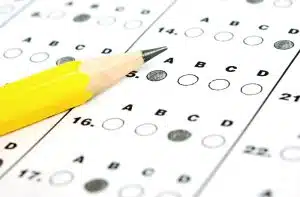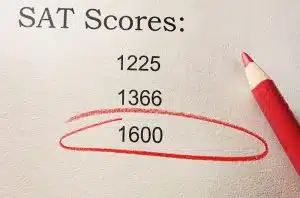What is a Good SAT Score?
As you begin exploring your college options, you might have already encountered the SAT. This standardized test plays a central role in college admissions, serving as a primary tool for colleges to gauge academic readiness. However, when it comes to defining what a good SAT score is, the answer isn’t straightforward and depends on several factors.
The SAT is a test that measures your skills in reading, writing, and math. Colleges use it to see how ready you are for college-level work. But it’s not just about getting the highest score possible. It’s about getting a score that opens doors to the colleges you want to attend.
In this guide, we’ll break down everything you need to know about the SAT. We’ll look at what the SAT is, how it’s scored, and what colleges are looking for. We’ll also talk about how to figure out a good score for you personally. Whether you’re aiming for an Ivy League school or your local state college, we’ve got you covered.
We’ll even share tips on how to improve your score and balance SAT prep with your other responsibilities. Plus, we’ll answer some common questions. So, let’s get started. Understanding what a good SAT score is can help you set the right goals and plan how to achieve them. And don’t worry; we’ll keep things simple and straight to the point. After all, we know you’ve got a lot on your plate!
Understanding SAT Scores
The SAT might seem like just another test, but it’s a key step in your journey to college. Let’s dive in and understand what this test is all about.
What is the SAT?
The SAT, which stands for Scholastic Assessment Test, is a standardized test used by colleges in the United States to help make admissions decisions.
Think of it as a common measure that helps colleges compare students from different high schools. Since everyone’s high school courses and grading systems are different, the SAT provides a way for colleges to look at all students on the same scale.
What is the Purpose of the SAT?
The SAT is developed and administered by the College Board, a non-profit organization in the United States. Originally created to democratize college admissions, the SAT aims to give all students, regardless of their background, an equal shot at college. It tests your readiness for college by assessing skills you’ve learned in high school, like reading comprehension, mathematical problem-solving, and clear writing.
Structure of the SAT
Understanding the structure of the SAT can help you prepare better. The test has four main sections:
- Reading Section: This part assesses your reading comprehension skills. You’ll encounter a variety of passages taken from literature, historical documents, and texts in the social and natural sciences. Your task is to read these passages and answer questions that test your understanding of their content.
- Writing and Language Section: This section focuses on your grasp of English grammar and writing style. You’ll be presented with passages that contain errors or weaknesses in writing. Your job is to identify and correct these issues, demonstrating your knowledge of standard English conventions and effective writing.
- Math Section: The Math section is split into two parts: one that permits the use of a calculator and one that does not. The questions cover a range of mathematical areas, including algebra, problem-solving, data analysis, and some more advanced topics in math.
- Essay (Optional): Previously a mandatory part of the SAT, the Essay section has become optional and was eventually discontinued in 2021. If you choose to take it, or if it’s required by the colleges you’re applying to, this section involves writing an essay. You’ll analyze how an author constructs an argument to persuade their audience.
It’s important to note recent changes to the SAT. For example, the College Board, which oversees the SAT, has announced plans to digitize the test. This means future SATs will be conducted on computers rather than the traditional pencil-and-paper format. Staying updated with these changes is crucial for effective preparation.
Remember, each section of the SAT is designed to measure specific skills that are essential for success in college. Understanding the structure of the SAT and the type of questions you’ll face in each section can greatly aid in your preparation and improve your chances of achieving a high score.
The SAT Scoring System
The SAT scoring system is a straightforward but essential aspect to understand for any high school student preparing for the test. It’s like understanding the rules of a game; knowing how it works helps you strategize to achieve the best possible score. Here’s a simple breakdown:
The SAT Scoring Scale:
- The total SAT score ranges from 400 to 1600. This is a combination of scores from two main sections: Evidence-Based Reading and Writing, and Math.
- Each section contributes a score that can range from 200 to 800. These two scores are then added together to give you your total SAT score.
Breaking Down the Individual Sections
Evidence-Based Reading and Writing: This section is a combination of the Reading and Writing segments. Each of these parts is scored separately, but their scores are combined to give you a single section score ranging from 200 to 800.
Math Section: The Math section also receives a score ranging from 200 to 800. Like the Evidence-Based Reading and Writing section, this score reflects your proficiency in the math content tested on the SAT.
Your total SAT score is the sum of your scores in these two sections. By understanding this scoring system, you can better target your study efforts. For instance, if you’re stronger in Math than in Reading and Writing, you might focus more on the latter to balance your scores and maximize your total score. Keep in mind, that the higher your total score, the more competitive your college application may appear to admissions committees.
Percentile Ranks
Percentile ranks are a way of showing how your SAT score compares with other students. Think of it as a ranking system. If you’re in the 60th percentile, for example, it means you did better than 60 out of 100 students. It’s not just about how many questions you answered correctly but how well you did relative to everyone else who took the test.
SAT Composite Score with Equivalent Percentile Score
|
SAT Composite Score |
Percentile Score |
| 1550-1600 | 99-99+% |
| 1500-1550 | 98-99% |
| 1450-1500 | 96-98% |
| 1400-1450 | 94-96% |
| 1350-1400 | 90-94% |
| 1300-1350 | 86-90% |
| 1250-1300 | 81-86% |
| 1200-1250 | 74-81% |
| 1150-1200 | 67-74% |
| 1100-1150 | 59-67% |
| 1050-1100 | 50-59% |
| 1000-1050 | 41-50% |
| 950-1000 | 33-41% |
| 900-950 | 25-33% |
| 850-900 | 18-25% |
| 800-850 | 11-18% |
| 750-800 | 6-11% |
| 700-750 | 3-6% |
| 650-700 | 1-3% |
| 600-650 or Below | 1% or Below |
Understanding percentiles is important because colleges use them to see where you stand among other applicants. Even if your total SAT score isn’t the highest possible, being in a high percentile rank can still be quite impressive.
It shows you’re ahead of the majority of test-takers, and colleges consider this as they decide who they want to admit. A high percentile rank is a way of demonstrating your academic abilities compared to peers nationally, making it a significant part of your college application.
The Concept of a Good Score: Subjective vs Objective Perspectives
So, what’s a good SAT score? Well, it’s not a one-size-fits-all answer. When you’re trying to figure out what a good SAT score is, remember that it really depends on your own goals and the colleges you want to get into. For some people, a good score is simply one that’s better than they’ve done before or one that gets them into their chosen college program.
From your own personal viewpoint, a good SAT score is one that hits the target you’ve set for yourself, especially if that target is based on the requirements of the colleges you’re aiming for. Say you’ve got your eye on a particular college, and you know that the average SAT score they accept is 1200. If you hit or surpass that score, then that’s a good score for you because it’s aligned with your personal goals.
Looking at it from a broader angle, you could think of a good score as one that’s above the national average or above the average score that students accepted into your chosen college receive. Statistically speaking, if you’re scoring above the 75th percentile, that means you’re doing better than three-quarters of the students taking the SAT, which is definitely considered good. And if you’re looking at very competitive colleges, you might need to be in the top 10% of scorers to stand out.
Below outlines the range of SAT scores and categorizes them based on their strength from a college admission perspective. Here’s a breakdown:
| 1550-1600 | Excellent (no need to retake) |
| 1500-1540 | Excellent (may consider retaking to break past 1550+, which is the ideal score) |
| 1400-1490 | Good |
| 1300-1390 | Average |
| 1100-1290 | Room for Improvement |
| 1100 – Below | Weak |
- Scores from 1550 to 1600 are considered excellent. There’s really no need to retake the SAT if you score in this range because you’ve already hit the higher echelons of what’s possible. This is typically beyond what is needed for even the most competitive colleges.
- If you score between 1500 to 1540, you’re also in the excellent range. However, some might consider retaking the SAT to push past the 1550 mark, which some perceive as an ideal score. But honestly, at this level, you already have a good SAT score that will be competitive at most universities.
- A score from 1400 to 1490 is seen as good. It means you’re well above average compared to other test-takers and should be competitive at many universities, though the most selective schools might be looking for scores in the higher band.
- Achieving between 1300 to 1390 puts you around the average range. It’s a good SAT score, but not particularly high or low. At this range, you’re doing better than a lot of students, but there’s still a bit of room to grow if you’re aiming for the top schools.
- A score from 1100 to 1290 indicates there’s room for improvement. It’s not a bad score, but if you’re looking to be competitive at more selective schools, it would be beneficial to retake the SAT to try and move up to a higher score range.
- If you score below 1100, this is considered weak in the context of college admissions. It suggests that you might struggle with the SAT content and could benefit from additional study or test prep resources to improve.
In all these categories, a good SAT score is relative to the colleges you’re applying to and your own academic goals. The higher your score, the more opportunities you may have, especially with competitive programs and scholarships. If you’re not sure where you stand or what you should be aiming for, look at the average SAT scores for the colleges on your list. This will give you a good idea of what a good SAT score is for you.
In the end, a good SAT score is one that puts you in a strong position for your future academic endeavors, whether that’s meeting your own personal benchmarks or standing out in the college admissions process.
The SAT is just one part of your college application. A score that might be considered just okay for one college could be great for another. It’s all about finding the right fit for you.
Understanding the SAT scoring system, percentile ranks, and what constitutes a good score is key to setting realistic and achievable goals for yourself. As you prepare for the SAT, keep these points in mind, and remember, a good score is one that helps you get into a college that’s right for you.
Benchmarks for a Good SAT Score
As you prepare for the SAT, you might be wondering, “What score should I aim for?” Understanding the benchmarks for a good SAT score can help you set realistic and strategic goals. Let’s dive into what these benchmarks look like and how to set your own target score.
Average SAT Scores for National Admissions
When you’re getting ready for the SAT, it’s useful to know the national average score, which usually is between 1050 and 1060. But according to the latest report by the College Board for 2023, the average has dipped a bit to 1028. This number comes from adding two parts: 520 from the Evidence-Based Reading and Writing (ERW) section and 508 from the Math section. Scoring above this average is generally considered good, but remember, the “right” score depends on your personal college goals.
What the SAT Average Score Means
An average score shows you the middle ground. It is calculated from the scores of many students from all over the country, which makes it a good standard to measure your own score against. If your score is higher than the average, it means you’re doing better than many other students across the nation. This can be a helpful way to gauge how well you might do in the college admissions process, as it gives you an idea of where you stand academically.
Score Ranges for Different Types of Colleges
Different colleges have their own SAT score expectations. If you’re looking at top-tier colleges, like the Ivy League, you’ll need to aim high. These schools often expect SAT scores in the top 10%, which generally means 1400 or above. They’re looking for students who really stand out academically.
For mid-tier colleges, including many state universities and private colleges, the SAT score expectations might be a bit more flexible. Scores that are around the national average, or just above, are often good enough. This means you might be aiming for something between 1100 and 1300 to fit well with these schools.
Then there are colleges where your SAT score is just one part of what they look at when deciding if you get in. For these schools, even if your score is around or a bit below the national average, you could still be a strong candidate. They consider your SAT score along with other factors like your high school grades, activities, and essays.
Below are all the top universities and colleges in the US categorized from the National Universities, National Liberal Arts Colleges, and Public Schools and the SAT scores they are looking for in an applicant.
Top 50 National Universities
| Rank | National Universities | SAT Score Range |
| 1 | Princeton University | 1460 – 1570 |
| 2 | Harvard University | 1480 – 1580 |
| 3 | Columbia University | 1460 – 1570 |
| 4 | Massachusetts Institute of Technology | 1510 – 1580 |
| 5 | Yale University | 1480 – 1580 |
| 6 | Stanford University | 1470 – 1570 |
| 7 | University of Chicago | 1510 – 1580 |
| 8 | University of Pennsylvania | 1480 – 1570 |
| 9 | Northwestern University | 1460 – 1560 |
| 10 | Duke University | 1480 – 1570 |
| 11 | Johns Hopkins University | 1510 – 1570 |
| 12 | California Institute of Technology | 1530 – 1580 |
| 13 | Dartmouth College | 1440 – 1560 |
| 14 | Brown University | 1460 – 1570 |
| 15 | University of Notre Dame | 1410 – 1550 |
| 16 | Vanderbilt University | 1480 – 1570 |
| 17 | Cornell University | 1450- 1560 |
| 18 | Rice University | 1490 – 1570 |
| 19 | Washington University in St. Louis | 1490 – 1570 |
| 20 | University of California–Los Angeles | 1290 – 1520 |
| 21 | Emory University | 1420 – 1540 |
| 22 | University of California–Berkeley | 1290 – 1530 |
| 23 | University of Southern California | 1410 – 1540 |
| 24 | Georgetown University | 1410 – 1550 |
| 25 | Carnegie Mellon University | 1480 – 1560 |
| 26 | University of Michigan–Ann Arbor | 1360 – 1530 |
| 27 | Wake Forest University | 1350 – 1500 |
| 28 | University of Virginia | 1390 – 1530 |
| 29 | Georgia Institute of Technology | 1360 – 1540 |
| 30 | New York University | 1450 – 1570 |
| 31 | Tufts University | 1440 – 1550 |
| 32 | University of North Carolina–Chapel Hill | 1320 – 1510 |
| 33 | University of Rochester | 1370 – 1520 |
| 34 | University of California–Santa Barbara | 1230 – 1480 |
| 35 | University of Florida | 1300-1470 |
| 36 | University of California–Irvine | 1215 – 1450 |
| 37 | Boston College | 1420 – 1530 |
| 38 | University of California–San Diego | 1260 – 1480 |
| 39 | University of California–Davis | 1140 – 1400 |
| 40 | Boston University | 1360 – 1520 |
| 41 | Brandeis University | 1370 – 1530 |
| 42 | Case Western Reserve University | 1410 – 1530 |
| 43 | College of William and Mary | 1360 – 1520 |
| 44 | Northeastern University | 1430 – 1550 |
| 45 | Tulane University | 1360 – 1510 |
| 46 | University of Wisconsin–Madison | 1340 – 1510 |
| 47 | Villanova University | 1350 – 1490 |
| 48 | University of Illinois–Urbana-Champaign | 1330 – 1530 |
| 49 | University of Texas–Austin | 1230 – 1500 |
| 50 | Lehigh University | 1325 – 1490 |
Top 50 National Liberal Arts Colleges
|
Rank |
National Liberal Arts Colleges |
SAT Score Range |
| 1 | Williams College | 1460 – 1560 |
| 2 | Amherst College | 1440 – 1570 |
| 3 | Swarthmore College | 1430 – 1560 |
| 4 | Wellesley College | 1400 – 1540 |
| 5 | Pomona College | 1470 – 1570 |
| 6 | Bowdoin College | 1320 – 1520 |
| 7 | Carleton College | 1410 – 1550 |
| 8 | Claremont McKenna College | 1420 – 1530 |
| 9 | Middlebury College | 1380 – 1530 |
| 10 | Washington and Lee University | 1410 – 1530 |
| 11 | Colby College | 1400 – 1530 |
| 12 | Haverford College | 1420 – 1540 |
| 13 | Smith College | 1370 – 1530 |
| 14 | Grinnell College | 1370 – 1530 |
| 15 | Hamilton College | 1410 – 1540 |
| 16 | Vassar College | 1420 – 1540 |
| 17 | Colgate University | 1340 – 1500 |
| 18 | Davidson College | 1330 – 1490 |
| 19 | United States Naval Academy | 1200 – 1420 |
| 20 | Wesleyan University | 1300 – 1510 |
| 21 | Bates College | 1260 – 1470 |
| 22 | United States Military Academy | 1200-1440 |
| 23 | Harvey Mudd College | 1480 – 1560 |
| 24 | University of Richmond | 1310 – 1490 |
| 25 | Barnard College | 1425 – 1550 |
| 26 | Macalester College | 1340 – 1515 |
| 27 | Bryn Mawr College | 1260 – 1490 |
| 28 | College of the Holy Cross | 1240 – 1420 |
| 29 | Colorado College | 1250 – 1455 |
| 30 | Kenyon College | 1340 – 1500 |
| 31 | Soka University of America | 1205 – 1400 |
| 32 | Mount Holyoke College | 1300 – 1510 |
| 33 | Oberlin College | 1338-1460 |
| 34 | Scripps College | 1380 – 1520 |
| 35 | Bucknell University | 1210 – 1410 |
| 36 | Pitzer College | 1390 – 1513 |
| 37 | Thomas Aquinas College | 1170 – 1370 |
| 38 | Franklin and Marshall College | 1240 – 1430 |
| 39 | Lafayette College | 1300 – 1460 |
| 40 | Occidental College | 1340 – 1490 |
| 41 | Skidmore College | 1270 – 1440 |
| 42 | United States Air Force Academy | 1208 – 1490 |
| 43 | Denison University | 1230 – 1430 |
| 44 | The University of the South | 1200 – 1390 |
| 45 | Union College | 1270 – 1450 |
| 46 | Berea College | 1118 – 1268 |
| 47 | Connecticut College | 1333 – 1476 |
| 48 | DePauw University | 1160 – 1420 |
| 49 | Dickinson College | 1373 – 1456 |
| 50 | Furman University | 1240 – 1420 |
Top 50 Public Schools
|
Rank |
Public Schools |
SAT Score Range |
| 1 | University of California–Los Angeles | 1270 – 1520 |
| 2 | University of California–Berkeley | 1300 – 1530 |
| 3 | University of Michigan–Ann Arbor | 1330 – 1510 |
| 4 | University of Virginia | 1330 – 1500 |
| 5 | Georgia Institute of Technology | 1390 – 1540 |
| 6 | University of North Carolina–Chapel Hill | 1270 – 1470 |
| 7 | University of California–Santa Barbara | 1230 – 1480 |
| 8 | University of Florida | 1280 – 1440 |
| 9 | University of California–Irvine | 1180 – 1440 |
| 10 | University of California–San Diego | 1250 – 1470 |
| 11 | University of California–Davis | 1150 – 1410 |
| 12 | College of William and Mary | 1310 – 1490 |
| 13 | University of Wisconsin–Madison | 1300 – 1480 |
| 14 | University of Illinois–Urbana-Champaign | 1220 – 480 |
| 15 | University of Texas–Austin | 1230 – 1480 |
| 16 | University of Georgia | 1240 – 1410 |
| 17 | Ohio State University–Columbus | 1240 – 1450 |
| 18 | Florida State University | 1200 – 1350 |
| 19 | Pennsylvania State University—University Park | 1160 – 1360 |
| 20 | Purdue University–West Lafayette | 1180 – 1410 |
| 21 | University of Pittsburgh | 1270 – 1430 |
| 22 | Rutgers University–New Brunswick | 1190 – 1410 |
| 23 | University of Washington | 1220 – 1460 |
| 24 | University of Connecticut | 1210 – 1420 |
| 25 | University of Maryland–College Park | 1290 – 1480 |
| 26 | University of Massachusetts–Amherst | 1200 – 1390 |
| 27 | Clemson University | 1220 – 1400 |
| 28 | Texas A&M University–College Station | 1170 – 1380 |
| 29 | University of Minnesota–Twin Cities | 1270 – 1480 |
| 30 | Virginia Tech | 1180 – 1390 |
| 31 | Binghamton University–SUNY | 1310 – 1440 |
| 32 | Indiana University–Bloomington | 1150 – 1360 |
| 33 | University at Buffalo–SUNY | 1160 – 1330 |
| 34 | Colorado School of Mines | 1290 – 1450 |
| 35 | Michigan State University | 1110 – 1310 |
| 36 | North Carolina State University–Raleigh | 1250 – 1390 |
| 37 | University of California–Santa Cruz | 1170 – 1400 |
| 38 | University of Iowa | 1120 – 1330 |
| 39 | Miami University–Oxford | 1200 – 1380 |
| 40 | Stony Brook University–SUNY | 1230 – 1420 |
| 41 | University of California–Riverside | 1110 – 1330 |
| 42 | University of Delaware | 1170 – 1350 |
| 43 | New Jersey Institute of Technology | 1190 – 1380 |
| 44 | Auburn University | 1150 – 1310 |
| 45 | Temple University | 1130 – 1320 |
| 46 | University of California–Merced | 1000 – 1190 |
| 47 | University of Colorado–Boulder | 1150 – 1360 |
| 48 | University of Oregon | 1080 – 1290 |
| 49 | University of South Carolina | 1190 – 1360 |
| 50 | University of South Florida | 1170 – 1330 |
Each table outlines the SAT score ranges for various colleges, which can help you understand what a good SAT score might look like depending on where you’re aiming to apply.
For the Top 50 National Universities, which includes prestigious institutions like Princeton, Harvard, and MIT, a good SAT score is quite high. These universities typically see scores from 1460 up to the 1580s. Achieving in this range suggests that you are academically prepared for the rigorous environments of these top-tier schools.
The Top 50 National Liberal Arts Colleges, such as Williams College, Amherst College, and Swarthmore, also look for high SAT scores, generally ranging from the 1400s to the mid-1570s. A good SAT score here would place you comfortably within these ranges, signifying that you’re a strong candidate for these smaller, yet highly respected, institutions.
When considering the Top 50 Public Schools, like the University of California, Los Angeles, or the University of Michigan, Ann Arbor, the expected SAT score ranges can be a bit broader, starting from the 1230s and reaching up to the 1540s. A good SAT score in this context means scoring above the lower end of these ranges, ideally closer to the upper end, to increase your competitiveness.
Overall, a good SAT score is relative to the average scores of admitted students at the colleges you’re interested in. For more competitive schools, you’ll need to score higher to be considered a strong applicant. It’s important to aim for a score that not only falls within the typical range of scores these schools accept but also aligns with your personal goals and the specific program or college you hope to get into.
Determining Your Target Score
Deciding on your SAT target score is a key step in your college prep strategy. Here’s a game plan to help you figure it out:
1. Do Your Homework: Start by digging into the data. Most colleges post the average SAT scores of their incoming class on their websites. Peek at these numbers for the schools on your wishlist. It’s like checking the stats for your in-game character – you want to know what you’re aiming for.
2. Aim High, But Keep It Real: Once you’ve got those average scores in mind, set a goal that feels like a stretch but isn’t a moonshot. Think about where you stand now academically and how much you can level up before test day.
3. Strategize Your Prep: If you’re scoring lower than your goal, don’t fret. Sketch out a battle plan. Maybe you need to hit the books harder, challenge yourself with more practice tests, or bring in a tutor as your Yoda.
4. Look at the Whole Map: Keep in mind, the SAT isn’t the boss level – it’s part of the entire game. Colleges are also scoping out your grades, your actions in the extracurricular arena, the stories you tell in your essays, and the sparkle in your recommendations.
Nailing a good SAT score is about aligning with the benchmarks set by your chosen colleges and enhancing your application. Knowing the score ranges for different schools gives you a target to shoot for. And remember, prepping for the SAT is not a sprint; it’s more like a marathon with a sweet reward at the finish line – admission to a college where you can thrive.
What Do Colleges Look For?
When you apply to college, your SAT score is a key piece of the puzzle. But what do colleges really look for when they see your SAT scores? Let’s explore how colleges interpret these scores and their role in the bigger picture of your application.
How Colleges Interpret SAT Scores
Colleges look at your SAT scores to get a sense of your academic abilities. These scores help them compare you to other students who are applying. But it’s not just about how high your score is. Colleges also think about where you’re coming from, like your high school and the kinds of classes and opportunities you had.
Your SAT score isn’t the only thing that matters. Colleges consider the whole picture, which includes your grades in high school, the kinds of classes you took, and other things you’ve achieved. They look at all of this to try to figure out how you might handle college classes. So, while a good SAT score can definitely help your application, colleges want to see a strong overall record that shows you’re ready for the challenge of college academics.
The Role of SAT Scores in Holistic Admissions
In the realm of college admissions, the term ‘holistic’ is thrown around quite a bit. But what does it actually mean for you and your SAT scores? Holistic admissions is an approach that colleges and universities use to get a full picture of who you are as an applicant rather than making a decision based solely on numerical data like test scores and GPA.
When a college says it practices holistic admissions, it’s looking at the entire spectrum of your experiences, achievements, and potential. Your SAT scores are part of this mix, but they aren’t the end-all of your application. Colleges understand that students are more than just numbers. So while a strong SAT score can certainly enhance your application, it isn’t the only factor that admissions officers consider.
SAT Scores in Context
In the holistic review process, SAT scores serve as a standard metric that can be used to compare students from different high schools and backgrounds on a common scale. However, these scores are considered alongside the difficulty of your high school curriculum, your grades, and the trends in your academic performance. If you’ve shown improvement over your high school career or taken on challenging AP or IB courses, that growth can be just as impressive as a high SAT score.
The Importance of Grades
Your high school GPA is often seen as a more consistent indicator of your academic abilities than your SAT scores. It represents four years of work in a variety of subjects and demonstrates your ability to perform across the board. A high GPA can sometimes offset a lower SAT score, as it suggests that you’re hardworking and capable of handling difficult coursework over time.
Extracurricular Activities and Leadership
What you do outside of the classroom tells colleges a lot about your interests, passions, and time management skills. Leadership roles, community service, sports, clubs, and other activities can all showcase your abilities and what you might contribute to the campus community. Colleges are looking for students who will be engaged and bring new perspectives and talents to their student body.
Essays: Your Voice, Your Story
Your essays are your chance to speak directly to the admissions committee. They are where you can explain your background, discuss significant experiences, and reflect on what you’ve learned. Essays can reveal your personality, values, and how you approach problems—factors that SAT scores can’t convey.
Letters of Recommendation: A Professional Perspective
Letters of recommendation provide insights into your character and potential from the viewpoints of teachers, counselors, and others who know you in an academic or professional capacity. They can confirm and expand upon the story your grades and test scores tell.
Overall, in holistic admissions, SAT scores are a starting point, not the deciding factor. Colleges are striving to gather a student body that is diverse, not just in academic strengths but in life experiences and perspectives. They’re interested in what makes you unique and how you’ll fit into the tapestry of their school’s community.
Your SAT scores can open doors, but it’s your full application—your essays, recommendations, activities, and grades—that will walk you through them. Every part of your application offers another facet of your story. So, when preparing for college, it’s important to put your best foot forward in every area, not just on the SAT.
Admission Criteria from Various Colleges
When it comes to getting into college, your SAT score is important, but it’s not the only thing colleges look at. Different colleges have their own ways of weighing your SAT score against other parts of your application.
- Ivy League Schools: These are some of the most competitive colleges out there. They usually want to see SAT scores in the highest percentiles. But it’s not all about test scores. They also really care about how well you’ve done in school overall, if you’ve taken on leadership roles, and if you have special talents or achievements.
- State Universities: These schools often have a broader approach to admissions. Yes, they do look at SAT scores, but they also give a lot of weight to your high school GPA and what you’ve been involved in, like clubs, sports, or community service. They’re often looking for students who have shown they can balance good grades with being active in their school or community.
- Liberal Arts Colleges: These colleges might not focus on your SAT scores as much as larger universities. They tend to look closely at your essays and the things you’ve done outside of class. They’re interested in getting to know who you are as a person and how you might fit into their college community.
Colleges use your SAT score to help them guess how well you’re going to do in college classes. But it’s just one piece of your whole application. They’re also looking for students who will bring something special to their campus, like different experiences, ideas, or talents.
So, while it’s good to work hard to get a good SAT score, don’t forget to spend time on your essays and extracurricular activities and make sure your grades stay strong. All these things together make up the big picture that colleges will look at when they decide if they want you to join their school.
Improving Your SAT Score
Boosting your SAT score is a mission that requires a mix of dedication, smart tactics, and a bit of endurance. It’s not just about how many hours you put in; it’s about making each hour count with focused and effective strategies. Let’s dive into how you can level up your SAT game.
Preparation Strategies and Tips
To start, you need a solid plan. Here are some tips to guide your preparation:
- Craft a Battle Plan: Like any major quest, you need a map. Break down your study material into manageable chunks and assign them to specific days or weeks. Stick to this routine as if it’s your training montage in a movie. Consistency transforms good intentions into great scores.
- Decode the SAT: Become an expert on the SAT’s landscape. Understand the types of questions and challenges you’ll face in each section. Knowing the enemy is half the battle won.
- Target Your Weak Spots: We’ve all got our Achilles’ heel, whether it’s geometry or grammar. Pinpoint yours by reviewing past tests or quizzes. Then, attack these weak areas with focused practice. It’s like leveling up a character’s stats in a video game – the more you work on it, the stronger you get.
- Master the Art of Test-Taking: The SAT is a mental arena, and you need to be a strategist. Learn the tricks, like how to spot and eliminate the clearly wrong options, guessing smartly when needed, and pacing yourself so that you don’t rush or dawdle. These techniques can turn a tough question into a conquered one.
- Keep the Engine Running Smoothly: Never underestimate the power of the basics – eating healthy, getting regular sleep, and exercising. Think of these as the daily maintenance needed to keep your brain in peak condition.
- Practice Like You Play: Use practice tests to simulate the real SAT experience. Take them seriously, time yourself, and review your answers thoroughly afterward. Each practice test is a rehearsal for the big day.
- Harness the Power of Resources: There’s a treasure trove of resources out there. Online platforms offer practice questions and tests, while study guides break down concepts into digestible pieces. Don’t hesitate to reach out for a tutor if you need a more personalized approach.
- Analyze and Adapt: After each practice test, review your answers. Understand why you got questions wrong and how to get them right next time. This reflection is a powerful learning tool.
- Mindset Matters: Keep your spirits high and stress low. Believe in your ability to improve. A positive mindset can greatly influence your performance.
- Seek Support: Don’t go at it alone. Join a study group, or talk to friends who are also preparing for the SAT. Share tips and encourage each other.
- Stay Balanced: While prepping for the SAT is important, don’t let it consume you. Make time for friends, hobbies, and relaxation. A well-rounded life leads to a well-rounded student.
Remember, improving your SAT score isn’t an overnight miracle. It’s a journey of incremental gains and steady progress. With each day of preparation, you’re building towards not just a better score, but a more disciplined and knowledgeable you. Stay the course, and you’ll see the results of your efforts.
Resources for SAT Preparation
Moreover, when it comes to gearing up for the SAT, you’ve got a suite of tools at your disposal. Let’s zero in on some top resources that can help you get ready for test day.
Prep Books: Crack open an SAT prep book and you’ll find a wealth of knowledge. These books pack in practice questions, strategies for acing the test, and tips to keep your prep on track. ‘The Official SAT Study Guide’ by The College Board is like the textbook for the SAT – it’s made by the same people who created the test. ‘Barron’s SAT’ is another heavyweight that can help you train for the big day.
Online Learning: The internet is chock-full of SAT prep material. You can find interactive lessons that turn prep from snooze-fest to engaging. Khan Academy, for instance, offers a completely free course tailored to the SAT. It’s like having a digital coach guiding you through the maze of test prep.
Personal Tutors: If you’re looking for a custom-fit prep plan, a tutor might be your best bet. They can zero in on the areas where you’re struggling and give you feedback that’s tailored just for you. It’s like having a personal trainer for your brain.
No matter which tools you choose, the key is to use them consistently and deliberately. Think of each resource as a different type of workout for your brain – the more variety, the stronger and more versatile your test-taking skills will become.
The Importance of Practice Tests
Lastly, taking practice tests is like running drills for the big game day; they’re essential in your SAT training regimen. These tests are the scrimmage matches before your official showdown, and here’s how they set you up for a slam dunk on the actual test day.
Becoming Test-Savvy: First off, practice tests are like dress rehearsals for the SAT. They get you acquainted with the test’s format and the variety of questions you’ll encounter. By running through these practice rounds, you’ll get the hang of the SAT’s pacing and won’t get thrown off by any curveballs on the actual test.
Measuring Up: Like checking your stats after a game, practice tests show you how much you’ve leveled up. They give you a clear picture of how your preparation is shaping up and which areas still need beefing up. This way, you can track your improvements over time and make sure your study strategies are paying off.
Calming Your Nerves: Just like rehearsals help actors shake off stage fright, frequent practice tests can help ease those test-day jitters. The more you practice under test-like conditions, the more you normalize the experience. So, when the day comes, you’ll be ready to take on the SAT with confidence, not cold feet.
Reviewing Your Game Tape: After you’ve completed a practice test, it’s crucial to go over your answers thoroughly.
- Understand Your Errors: Examine each question you missed and break down why you missed it. Was it because you didn’t know the material? Did you read the question too quickly? Or did you run out of time? Getting to the root of each mistake helps you tackle these issues head-on.
- Spot the Trends: Keep an eye out for any recurring problems. Maybe there’s a specific type of math problem that trips you up or a common grammar mistake you make. Recognizing these trends is like a coach spotting weaknesses in a play; once you know what they are, you can work to correct them.
- Tweak Your Strategy: Use the intel from your practice tests to refine your study approach. If you’re strong in math but weak in writing, shift some focus to where it’s needed. Think of it as adjusting your training plan to target muscles that need more work.
Practice tests are non-negotiable in your SAT prep playbook. They’re not just about answering questions; they’re a strategic tool to fine-tune your performance. With each test, you learn a bit more about how to tackle the SAT, managing your time wisely, and keeping cool under pressure. Steady practice will not only sharpen your skills but also build the endurance you need to go the distance on test day.
Ultimately, improving your SAT score is definitely possible with the right approach and resources. Remember, it’s about steady progress, understanding your strengths and weaknesses, and staying committed to your study plan. With time and effort, you can achieve the score you’re aiming for.
Beyond the SAT Score
As you gear up for the college admissions process, it’s vital to understand that your SAT score is just one facet of your entire application. Sure, aiming for a good SAT score is crucial, but colleges are keen to paint a complete portrait of who you are, not just how you perform on one exam.
Think about your GPA; it’s like a highlight reel of your academic journey throughout high school. It tells colleges about your work ethic and intellectual curiosity across a spectrum of subjects. Then there are your extracurriculars—the clubs, sports, community service, and other passions that tell your story beyond the classroom. These activities can reflect what drives you, showcasing your leadership, creativity, and commitment.
Your essays are where your voice comes through. This is your conversation with the admissions committee, where you share your narrative, your values, and your vision. It’s a space to demonstrate your ability to reflect and articulate your thoughts.
Recommendations add another dimension, providing an external perspective on your character and capabilities. Teachers and counselors can vouch for your contributions in the classroom and your potential for future growth.
While the SAT requires a dedicated prep time, it’s about finding equilibrium with your other commitments. Creating a schedule that carves out time for studying, classes, and downtime can help maintain this balance. It’s about juggling your priorities without dropping the ball—some days, that might mean zeroing in on calculus homework, while others might be all about SAT vocab drills.
Remember, it’s okay to step back and breathe. Regular breaks can recharge your batteries and keep stress at bay. And if the load gets too heavy, reach out. A support system can be a game-changer, offering guidance or just a listening ear when you need it.
Also, in the shifting landscape of college admissions, many institutions now offer test-optional policies. This might be a path to consider if standardized tests aren’t your forte. If your strengths lie in your GPA, your extracurricular achievements, or your ability to craft compelling essays, a test-optional college might be an ideal fit. It’s worth researching which schools offer this flexibility and understanding how it aligns with your overall college strategy.
While a good SAT score can bolster your application, colleges are searching for dynamic individuals ready to bring their unique talents to campus. They’re interested in students who are more than just good test-takers—students who will contribute to and enrich the college community.
Frequently Asked Questions
Navigating the SAT can bring up a lot of questions. It’s natural to feel a bit confused or overwhelmed. In this section, we’ll tackle some of the most common questions and clear up any misconceptions about the SAT. We’ll also offer expert advice on retaking the SAT and keeping up-to-date with any changes to the test.
Let’s clear up some confusion and answer key questions about the SAT:
“Do I need a perfect score to get into a good college?”
No, you don’t need a perfect score. Colleges consider many factors, not just your SAT score. A balanced application with strong grades, extracurricular activities, and personal essays is also crucial.
“Is the SAT harder than the ACT?”
The SAT and ACT are different, but one isn’t necessarily harder than the other. The SAT focuses more on reasoning and problem-solving, while the ACT includes a science section and tends to be more straightforward.
“Can I guess on questions I don’t know?“
Yes, you can guess. The SAT doesn’t penalize for wrong answers. If you’re unsure, it’s better to guess than to leave a question blank.
“Should I take the SAT multiple times?”
Taking the SAT more than once can be beneficial. Many students improve their scores the second time around. However, it’s not necessary for everyone. Consider your first score and your target colleges before deciding.
Expert Advice on Retaking the SAT
If you’re mulling over whether to retake the SAT, here’s some straightforward advice from the experts. Consider how your first SAT score measures up against the average scores at the colleges you’re eyeing. A big difference between your score and their average might mean a retake could be beneficial, especially if you’re chasing a good SAT score that could swing open those college doors a little wider.
Before you decide to dive back into the world of SAT prep, think hard about what you’d do differently. Is there a fresh study method you can try, or certain areas you realize need more focus? Sometimes, a change in your approach can make a significant difference in your score.
However, don’t forget to weigh the other factors—like the hours you’ll need to invest and the stress that comes with it. You’ve got to balance the scales; make sure retaking the SAT won’t throw off your school responsibilities or your personal well-being.
As the SAT can evolve over time, keeping on top of these changes is crucial. The College Board’s official website is your go-to for the most current information. It’s the front line for anything and everything SAT-related.
Also, don’t overlook your school counselor—they’re there to help and can offer valuable insights into the SAT process. Plus, if you’re involved in any prep courses or have a tutor, they should also keep you in the loop about the latest SAT news.
Navigating the SAT landscape can feel like a maze sometimes, but with the right information and a solid plan, you can tackle it head-on. Retaking the SAT isn’t a step back; it’s a strategic move forward, and with diligent prep, you’re giving yourself another shot at nailing a good SAT score. Stay sharp, stay informed, and approach the SAT with the confidence of someone who’s ready to ace it.
Final Thoughts
So, what makes a good SAT score? A good SAT score is one that aligns with your college aspirations and helps you stand out in your applications. It’s a score that reflects your hard work and preparation, and it should make you proud, regardless of the number. Remember, a good score varies from student to student, depending on their target colleges and personal goals.
Approaching the SAT can feel overwhelming, but it’s an opportunity to showcase your abilities and dedication. Believe in yourself and the effort you put into studying. Even if you face challenges along the way, each step you take is a learning experience that prepares you not only for the SAT but for the exciting college journey ahead.
Stay motivated by setting realistic goals, seeking support when needed, and celebrating your progress, no matter how small. Your journey to a good SAT score is also a journey of personal growth. Embrace it with confidence and a positive attitude.
If you’re set on getting into a world-class college but aren’t sure how to make it happen, we can help! AdmissionSight is a leading college entrance expert with over a decade of experience helping students just like you get into the schools of their dreams.
At AdmissionSight, we focus on offering a wide range of services, including helping you become familiar with standardized tests, all aimed at helping you perfect your applications to catch the attention of admissions officers. Contact us today to schedule a free consultation and learn more about what we offer.















































